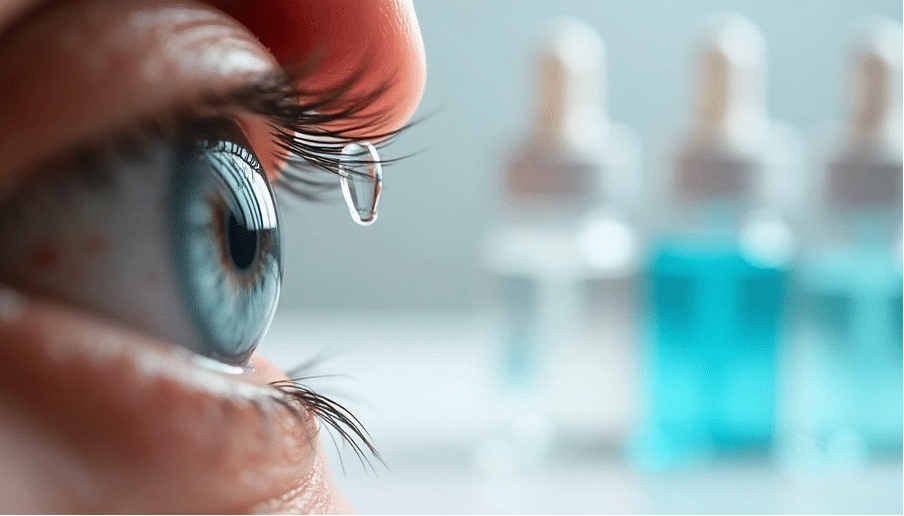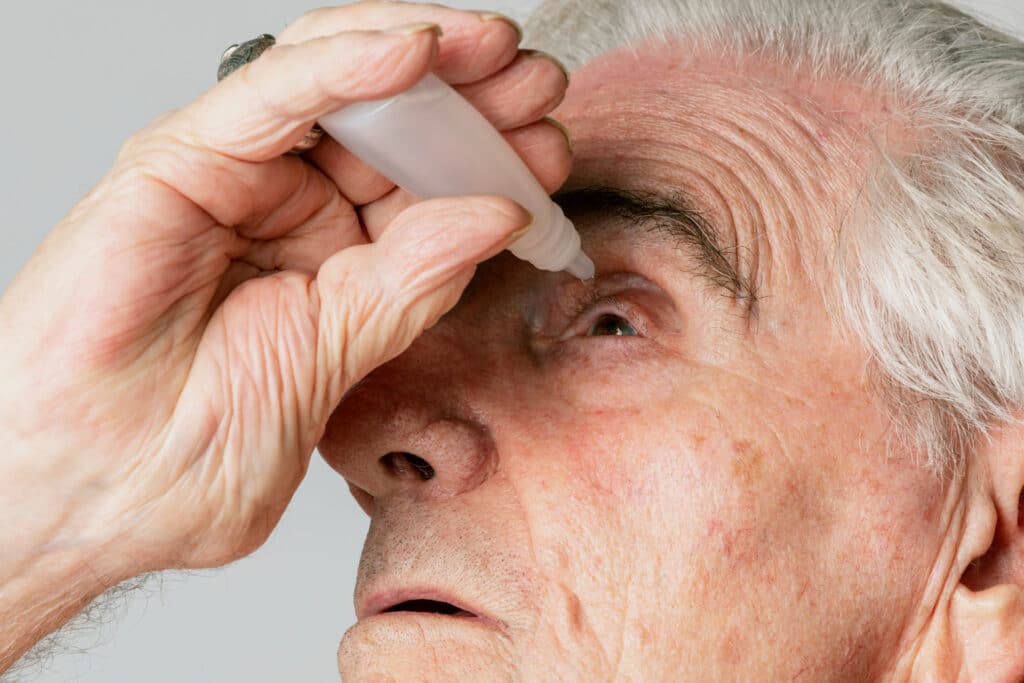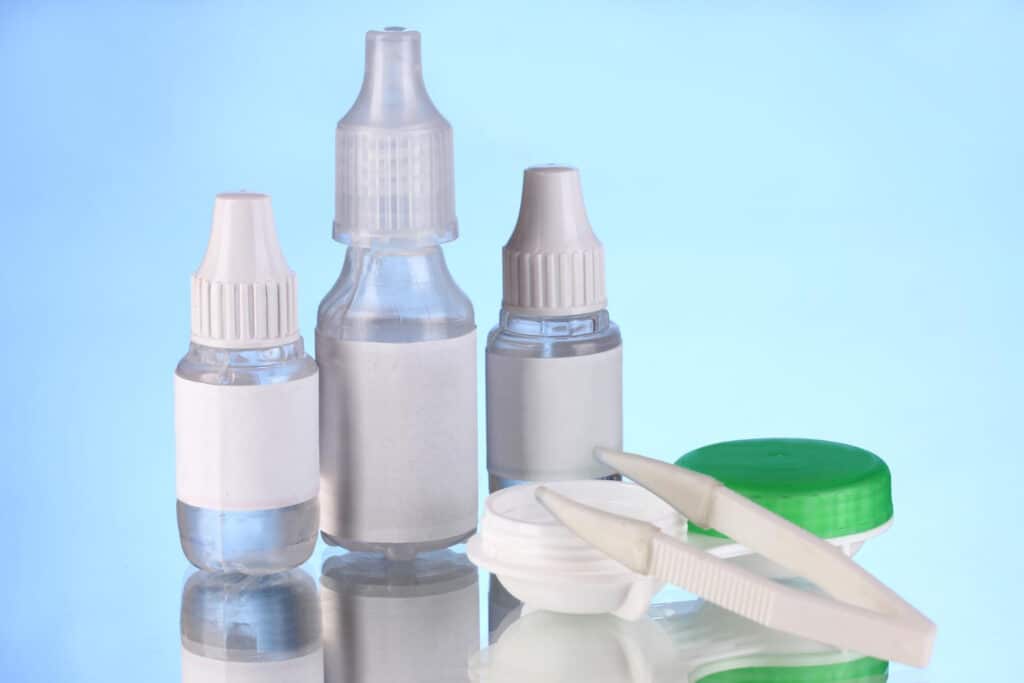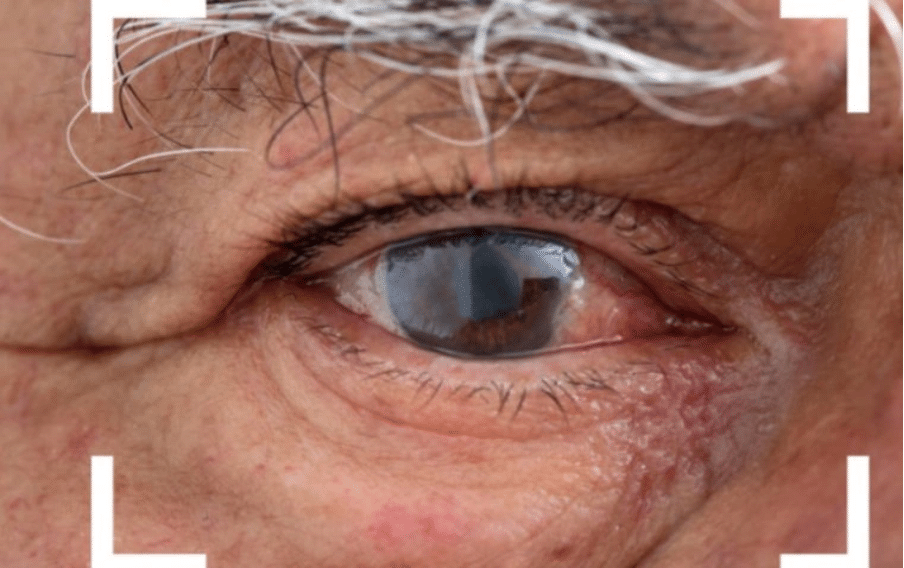What happens when you skip eye drops after cataract surgery? This small oversight could ruin your surgery’s success. Your eyes become vulnerable to infection and inflammation right after surgery. The tiny incision from the procedure leaves your eye exposed.
Eye drops protect your eyes during this crucial healing phase. These prescribed medications fight bacteria and reduce inflammation. They also help soothe any irritation while your eye heals. Skipping your post-surgery eye drops puts you at most important risks. You could face infection leading to redness, inflammation, and discharge. If left untreated, these complications might damage your eyesight. Your surgery’s benefits could diminish if you don’t stick to your post-operative care plan.

Why eye drops are essential after cataract surgery
Eye drops are vital to your recovery after cataract surgery. These medications aren’t optional extras – they directly affect your healing process and final vision outcome.
Preventing infection and inflammation
Your eye becomes especially vulnerable to bacterial contamination after cataract surgery. Antibiotic eye drops like Oftaquix or Exocin create a protective barrier against infection during this critical time. Research shows the risk of developing postoperative infections increases by a lot without proper antibiotic treatment. These infections can lead to severe complications and permanent vision loss if left untreated.
Surgery triggers what doctors call the arachidonic acid cascade in your eye. This process generates prostaglandins that cause redness, swelling and discomfort. Anti-inflammatory drops like Pred Forte or Maxidex work with NSAID drops such as Voltarol or Yellox to control this response. Studies show NSAIDs and corticosteroids are effective at rebuilding the blood-aqueous barrier.

Supporting tissue healing and vision clarity
Your prescribed eye drops help repair tissue and keep your vision clear during recovery. You might experience prolonged inflammation and persistent blurriness without anti-inflammatory treatment. Some patients develop cystoid macular oedema (CME), which occurred at a rate of 3.3% between 2005-2007. Corticosteroids and NSAIDs work together to prevent this complication. Most mild discomfort disappears after the first week. Complete healing usually takes 2 to 6 weeks. Your eye drops create the best conditions for recovery during this time.
Managing eye pressure and dryness
Your eye pressure might fluctuate after surgery, especially in the first 24 hours. These pressure spikes usually don’t last long but can cause problems if you have conditions like glaucoma. Your prescribed drops help maintain healthy pressure levels and keep your eye comfortable.
Dry eye often occurs after cataract surgery. This happens in part because medicated drops with preservatives might slow down healing temporarily. Lubricating drops like Hydramed, Thealoz Duo or Hyaloforte provide needed moisture. These drops reduce irritation and make your recovery more comfortable. Following your complete eye drop regimen isn’t just a suggestion – it’s essential to protect your vision and ensure the best surgical results.
What are the main types of post cataract surgery eye drops?
Your post-cataract surgery treatment will need four different types of eye drops. Each drop plays a unique role in your recovery. Let’s look at what these medications do and how they help you heal.
Antibiotic drops: Oftaquix / Exocin
These drops shield your eyes from infection during recovery. Oftaquix (levofloxacin 5mg/ml) and Exocin (ofloxacin 0.3%) are fluoroquinolone antibiotics that fight both Gramme-positive and Gramme-negative bacteria. You’ll need to put one to two drops in your treated eye every two hours (up to 8 times daily) for two days. After that, use them four times daily for three more days.
Anti-inflammatory drops: Pred Forte / Maxidex
Steroid drops such as Pred Forte (prednisolone 1%) and Maxidex (dexamethasone 0.1%) help manage inflammation after surgery. These drops reduce your eye’s redness, swelling, and irritation. Remember that using them too long might cause steroid-induced glaucoma or cataracts. Your typical schedule includes four drops daily for two weeks, followed by twice daily for another two weeks.

NSAID drops: Voltarol / Yellox
Non-steroidal anti-inflammatory drugs control inflammation without steroid risks. You’ll use Voltarol (diclofenac 0.1%) four times daily for up to 28 days. Yellox (bromfenac) requires two daily doses starting the day after surgery for two weeks. These medications excel at preventing cystoid macular oedema, a possible complication after your surgery.
Lubricating drops: Hydramed / Thealoz Duo / Hyaloforte
Many patients experience dry, gritty eyes after surgery. Lubricating drops provide comfort and moisture. Thealoz Duo combines trehalose 3% and sodium hyaluronate 0.15%. This combination improves your tear film thickness for up to 4 hours—six times longer than sodium hyaluronate alone. Hydramed’s blend of tamarind seed polysaccharide and sodium hyaluronate keeps your cornea hydrated longer.
How long do you use drops after cataract surgery?
Antibiotic drops usually last about a week. Your anti-inflammatory steroids will continue for 3-4 weeks with gradually decreasing doses. NSAID drops typically run for 2-4 weeks, though some high-risk patients might need them for up to 12 weeks. You can use lubricating drops whenever needed for several months to help with dryness. Remember to wait 1-2 minutes between different types of drops to prevent them from washing each other out.
What happens if you skip your prescribed eye drops?
Your post cataract surgery eye drops are not something you can skip. Research shows many patients don’t follow their medication schedule. Let’s get into what could go wrong if you skip your prescribed medications.
Increased risk of infection
Cataract surgery creates a small incision that leaves your eye open to bacterial contamination. Skipping antibiotic drops like Oftaquix or Exocin makes this risk much higher. Your eye could become red and discharge fluid. Without treatment, you might face permanent vision damage. Modern surgical techniques are great, but the risk of post-operative infection stays at 1:1,000. These antibiotic drops protect your eyes.
Prolonged inflammation and discomfort
Surgery triggers what doctors call the “arachidonic acid cascade.” This process creates prostaglandins that make your eye red, swollen, and painful. You need anti-inflammatory drops like Pred Forte or Maxidex to control this natural response. More than that, inflammation can last for weeks without treatment. This leads to severe pain (about 1 in 50 patients experience this).

Image Source: Ophthalmology Breaking News
Delayed healing and blurry vision
Your eye drops help repair tissue and keep your vision clear. Without them, healing slows down substantially. About 1 in 20 patients get blurry vision from retinal swelling after surgery. NSAID drops like Voltarol or Yellox are vital to prevent cystoid macular oedema that affects how well you see.
Higher chance of corneal oedema
Fluid builds up in your cornea when the endothelium (inner layer of cells) can’t pump it out quickly enough. This creates blurred vision and discomfort. Long-term corneal oedema can cause permanent subepithelial scarring. Your vision might stay limited even after treatment. Regular use of prescribed drops keeps this risk low.
Uncontrolled eye pressure and glaucoma risk
Eye drops after surgery control your intraocular pressure. Missing these medications lets pressure rise unchecked (happens to about 1:100 patients). This can damage your optic nerve permanently and might cause glaucoma.
Post-surgery eye drops aren’t optional—they’re vital. They protect against infection, reduce inflammation, and ensure proper healing. Don’t risk complications if you’ve had cataract surgery or plan to have one.
How to use your eye drops correctly for best results
Your medication will work best when you apply eye drops correctly after cataract surgery. Poor application techniques can make the medication less effective and slow down your healing.
Spacing between different drops
The right timing between medications stands out as one of the most significant parts of post-cataract eye drop schedules. Yes, it is important to wait three to five minutes between different eye drop medicines. This waiting period stops one medication from washing away another and helps each drop work properly.
You should wait one to two minutes between applying antibiotic drops (Oftaquix/Exocin), anti-inflammatory drops (Pred Forte/Maxidex), and NSAID drops (Voltarol/Yellox). Each medication needs this time to absorb into your eye’s tissues.
Tips for applying drops safely
Here’s how to apply eye drops the right way:
- Always wash your hands with soap and water before touching any eye drops.
- Position yourself comfortably sitting or lying down with your head tilted back, looking upward.
- Use one finger to pull your lower eyelid down gently and create a small pocket.
- Rest the bottle on your nose bridge or forehead, then squeeze one drop into the pocket without letting the tip touch your eye.
- After applying, close your eye and use a clean tissue to blot any extra liquid.
You can safely add another drop if you think the first one missed. People who find it hard to put drops in their eyes should ask someone they trust for help or try using a plastic applicator from their local pharmacy or vision support group.
What to do if you miss a dose
Apply the drop as soon as you notice you missed it—unless your next dose is coming up soon. Skip the missed dose and stick to your regular schedule if that’s the case. Never try to catch up by using extra drops. Your phone’s alarm or medication reminder apps can keep you on track with your dosing schedule.
When to contact your ophthalmologist
Call your eye doctor right away if you notice:
- Your vision gets worse
- Strong eye pain
- Yellow or green discharge
- Straight lines look wavy or distorted
- Your eyelids become very swollen or itchy
- Light bothers your eyes more than usual
- You feel nauseated or “seasick”
- You see new large floaters or flashing lights
Note that even the best eye drops can’t help if you don’t use them properly. The success of your surgery depends on how carefully you follow these application instructions.
Conclusion
Skipping your eye drop regimen after cataract surgery puts your recovery at risk. The healing period usually takes 4-6 weeks. During this time, medications protect you against infection, inflammation, and complications that could affect your surgical outcome. Your prescribed schedule must be followed strictly – whether you’re using antibiotics like Oftaquix, anti-inflammatories such as Pred Forte, or lubricating drops like Thealoz Duo.
The right way to apply these medications makes a big difference in how well they work. You should wait one to two minutes between different medications. Make sure to wash your hands before application. Call your ophthalmologist right away if your symptoms get worse. The hassle of sticking to an eye drop schedule is no match for what could go wrong if you don’t – including ongoing inflammation, infection, corneal oedema, or permanent vision problems.
Your careful post-operative care shapes how successful your cataract surgery will be. The procedure might take just minutes, but proper healing depends on the following weeks. Need advice about recovery or thinking about cataract surgery? Book a consultation at Precision Vision London to get expert guidance. Your eyesight is too valuable to take shortcuts with aftercare.
Key Takeaways
Skipping prescribed eye drops after cataract surgery can lead to serious complications that may permanently compromise your vision and surgical outcome.
- Post-surgery eye drops are essential for preventing infection, controlling inflammation, and ensuring proper healing over the critical 4-6 week recovery period.
- Without antibiotic drops, infection risk increases dramatically, whilst missing anti-inflammatory medications can cause prolonged swelling and delayed healing.
- Four main drop types are prescribed: antibiotics (Oftaquix/Exocin), steroids (Pred Forte/Maxidex), NSAIDs (Voltarol/Yellox), and lubricants for comfort.
- Proper application requires 1-2 minute gaps between different medications, clean hands, and correct positioning to maximise effectiveness.
- Contact your ophthalmologist immediately if you experience worsening vision, severe pain, discharge, or increased light sensitivity during recovery.
The inconvenience of following a strict eye drop schedule is minimal compared to the devastating consequences of neglect, including permanent vision impairment, corneal damage, or uncontrolled eye pressure leading to glaucoma.
FAQs
Q1. How long should I use eye drops after cataract surgery? Typically, you’ll need to use eye drops for about 4-6 weeks following your cataract surgery. The exact duration may vary depending on your specific healing process and your doctor’s recommendations.
Q2. Is it possible to have cataract surgery without using eye drops afterwards? While some clinics offer “dropless” cataract surgery, the standard procedure requires post-operative eye drops. These drops are crucial for preventing infection, reducing inflammation, and ensuring proper healing.
Q3. What signs indicate a problem after cataract surgery? If you experience worsening vision, severe eye pain, yellow or green discharge, distorted vision, excessive swelling or itching of eyelids, increased light sensitivity, or new large floaters, contact your ophthalmologist immediately as these could indicate complications.
Q4. Are there any side effects associated with post-cataract surgery eye drops? Some patients may experience side effects from anti-inflammatory drops, including increased eye pressure or delayed wound healing. However, these risks are generally minimal under proper medical supervision and are outweighed by the benefits of the medication.
Q5. What happens if I forget to use my eye drops after cataract surgery? Skipping your prescribed eye drops can lead to serious complications such as increased risk of infection, prolonged inflammation, delayed healing, and potentially compromised vision outcomes. If you miss a dose, apply it as soon as you remember, unless it’s almost time for your next scheduled dose.
Authors & Reviewer
-
 Olivia: Author
Olivia: AuthorHi, I'm Olivia, a passionate writer specialising in eye care, vision health, and the latest advancements in optometry. I strive to craft informative and engaging articles that help readers make informed decisions about their eye health. With a keen eye for detail and a commitment to delivering accurate, research-backed content, I aim to educate and inspire through every piece I write.
-
 Dr. CT Pillai: Reviewer
Dr. CT Pillai: ReviewerDr. CT Pillai is a globally recognised ophthalmologist with over 30 years of experience, specialising in refractive surgery and general ophthalmology. Renowned for performing over 50,000 successful laser procedures.

